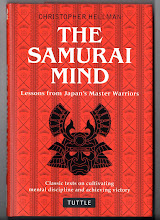 | ||
| Detail from a print by Chikanobu showing Ota Dokan |
Only a week ago, the cherry blossom was blooming and Kyoto was awash with frothy white and pale pink blossom and the happy faces of tourists and residents alike. The term ‘sakura fubuki’ refers to a flurry of cherry blossom falling in the breeze, a little storm of cherry blossom petals, though it could almost as well refer to the mass of people who are brought out by the seasonal phenomenon. Cherry blossom is beautiful anywhere, but Kyoto has a particularly high concentration: public parks, temple and shrine gardens, almost the whole stretch of the river that runs through the city, not to mention schools and university campuses suddenly bloom, all at more or less the same time, and the city is filled with a kind of excitement, charmed by beauty.
All good things must come to an end, and so the exuberance of the cherry blossom has passed, and the petals scattered, giving way to new leaves and a city filled with a new array of colours. It is not only cherry that flowers at this season – the camellias are in full bloom, azaleas are just beginning to come out, and wisteria, perhaps earlier than usual, can be seen as well.
Another common flower that marks the coming of spring is the yamabuki, sometimes known as Japanese kerria, mountain rose or Japanese rose. Its bright yellow flowers (the colour is known as yamabuki iro - pretty much the same as cadmium yellow for the painters reading this) appear at around the same time as the cherry blossom, but last for longer. Like cherry it has been the subject of poetry for well over a thousand years, appearing in a number of works in the Manyoshu, the extensive anthology composed in the 8th century.
 |
| Yamabuki in my neighbourhood |
Interestingly, it also played a minor part in the creation of possibly the most famous of all Japanese poems, Basho's haiku about a frog:
Furu ike ya
Kawazu tobikomu
Mizu no oto
Despite its simplicity, there have been many different translations. This is one of the most straightforward:
The old pond;
A frog jumps in-
The sound of water
(R.H. Blyth)
…while this is the version I like best:
The old pond
Leap – splash
A frog
(Lucien Stryk)
Accounts tell us that Basho had already come up with the final two lines, but was casting around for a beginning. His student (I presume) suggested ‘yamabuki’, (Yamabuki ya); the suggestion sparked Basho’s own idea, ‘The old pond’ (Furu ike ya), and he went with that instead. It seems there was a recognised connection between frogs and yamabuki going back to the aforemontioned Manyoshu, so Basho may have seen this as an overly conventional pairing, or perhaps felt it didn’t match the sound of the later lines. Hiroshige shows them together in one of his prints, as you can see here:
 | |
| A print by Hiroshige showing yamabuki and frogs |
Yamabuki has another, better known, poetic connection, this one based on a play on words. Dating back to the 10th century, a poem by Prince Kaneakira (914-987) is preserved in the anthology, Goshui Wakashu (1086). His own explanation for the poem goes that a visitor called on a rainy day, asking for a straw raincoat. Kaneakira replied by handing him a spray of yamabuki. The visitor left, perplexed. Next day, he returned and the prince composed a poem and gave it to him:
Nanae yae
Hana wa sakedomo
Mi no hitotsu dani
Naki no kanashiki
Yamabuki blooms with a wealth of petals*,
Yet in spite of this,
Sad to say, it bears no fruit
{*Nanae yae literally means 'sevenfold' and 'eightfold' and is used to mean many layered. Yaezakura are sakura (cherry) trees with many petals (more than the normal five, any way). Yamabuki also come in five-petalled or many-petalled varieties.}
There is a play on the similarity of mino (meaning raincoat) and mi no (meaning fruit + the participle ‘no’). The meaning is thus ‘just as the yamabuki has no fruit, I have no raincoat.
.jpg) |
| A Felice Beato photograph showing a mino |
Fast forward a few centuries, and the daimyo Ota Dokan (1432–1486) was out hunting when it started to rain. He happened to be near a hut (or mill in some versions) and going to the gate, called out for a raincoat (mino). The daughter of the house came out and silently offered him a branch of yamabuki instead. Dokan was non-plussed, and left (probably with a few choice words that did not make their way into the storyteller’s account).
 |
| A print by Ogata Gekko once again showing Ota Dokan and the yamabuki |
That evening, he recounted the story to one of his followers who explained about the poem of Prince Kaneakira. Dokan was embarrassed at his lack of poetic education, as well as realizing how elegantly the young woman avoided having to admit her family’s poverty. He resolved to study poetry and later became an accomplished poet himself. (There is no mention of whether he went back with a supply of raincoats or a fresh pheasant – the bushi class seemed to have enjoyed showing largesse, so I like to think he did).
It’s a nice story, and may even be true - but perhaps, as so often, the truth is a little more complicated (or prosaic) than that.









